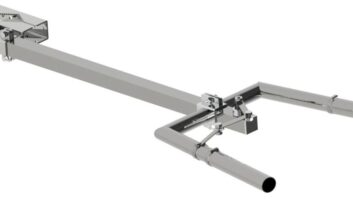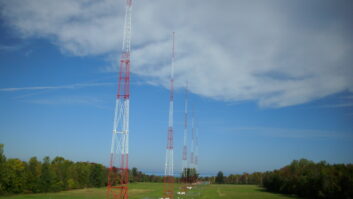Progress is slow for testing of two new antenna designs that have sparked interest – and skepticism – among AM station managers and engineers.
Tests on the CFA antenna, conducted by its proponents, had not begun by mid-November. Original plans had called for completion of those tests by early summer of 2001.
Meanwhile, the EH antenna underwent a first round of tests in October by its proponents. Those tests indicated that the initial EH design for the broadcast band is not an efficient radiator.
Tests on an EH antenna and compared to a standard broadcast antenna at radio station WKVQ(AM), Eatonton, Ga., indicated that the first EH antenna designed for the AM band suffers from poor efficiency.
“The mistake was due to the use of a network developed for the HF version of the EH Antenna (a dipole), which has a high radiation resistance and low capacity,” stated Ted Hart, chief executive officer of EH Antenna Systems on its Web site.
“The AM broadcast antenna had low radiation resistance and high capacity. Unfortunately, until the test at the radio station, we had not applied transmitter power, thus the inefficiency was not evident.”
Hart posted details about the initial test, conducted in October, on his Web site at www.eh-antenna.com
Hart told Radio World that a new, quarter-scale design was to be completed by the end of November. The design is intended to improve the match between the transmitter and the antenna. The result should be a full-scale antenna on which new tests will be performed.
“We expect … final field tests in early December,” Hart said.
Meanwhile, delays plague the other AM antenna under development, the CFA antenna project in Shropshire in the United Kingdom.
Robert Richer, president of CFA Limited, base in Farmington, Conn., indicated that the initial matching of a transmitter provided by NTL has taken longer than expected. The installation crew was still working on the phasing system in late November.
Once that phasing system is complete, the antenna’s inventor, Dr. Fathi Kabbary, was expected to travel to the site in England to perform the final matching adjustments and make the antenna operational. When the complete system is operational, Ben Dawson from Hatfield & Dawson will test the antenna. He originally planned to test it last spring.
CFA Limited hired Dawson as part of a joint project involving consulting engineering firms Hatfield & Dawson and duTreil, Lundin & Rackley, to supervise testing of the demonstration CFA in England.
Performance tests on the CFA have been delayed for nearly a year for numerous reasons including illness, bad weather and hoof and mouth disease near the test site. The latest delay is the result of the Sept. 11 terrorist attacks. Kabbary has been unable to fly from Egypt to the U.K. to finish the installation.
The CFA and EH antennas have been the subject of convention presentations and print articles as well as extensive industry debate.
AM owners are interested because both antennas promise higher efficiencies, greatly reduced radio frequency radiation around the antenna and the ability to install antennas on relatively small parcels of land and even building rooftops.
Skeptics in the broadcast engineering community believe neither antenna will be able to radiate efficiently enough to serve as a suitable substitute for the common standard broadcast antenna.












